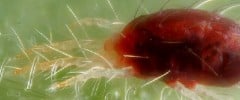How to Identify and Manage Thrips

Some of the most destructive insects are also the smallest, and thrips are no exception. These tiny pests can cause significant damage to many plant species. Among the most destructive is the western flower thrips, Frankliniella occidentalis.
Fortunately, this is not a common interior pest but is more of a greenhouse problem. The real threat to interior plants is the chilli thrips, Scirtothrips dorsalis. This species is often misidentified because its damage can look similar to that of broad mites. It also feeds on a variety of tropical foliage plants. Understanding why these insects are so destructive and how to identify them is crucial for effective control.
Why Are Thrips So Destructive?
Thrips like to feed on new plant growth emerging from the growing tips. An infestation can stunt the plant’s development and harm its buds, resulting in aesthetic damage to the plants. Also, thrips can transmit plant viruses. Luckily, most of these viruses are confined to vegetable and flower crops and don’t significantly impact plants commonly used in interior landscapes.
Identification
If you suspect a thrips infestation, bring a hand lens with you. Chilli thrips are incredibly small, pale, and measure about 0.5–1.2 mm in length, while western flower thrips are a bit darker and about 1.0–1.5 mm long. Depending on the species, they can be various colors. You can also identify chilli thrips by their feeding damage, which causes new growth to curl and distort. The foliage may also turn silvery or black.
Life Cycle
Chilli thrips take 2-3 weeks to complete their life cycle, with the duration influenced by temperature and the host plant. Females make cuts into leaves and insert their eggs into the tissue, where they will hatch. The newly hatched nymphs feed on the plant until they pupate. Chilli thrips pupae can be found on the foliage of the plant, in the soil, or tucked into blooms. It’s best to target their control on the plant itself, rather than in the soil like you would with western flower thrips.
Do You Have a Thrips Infestation?
If you suspect thrips, here’s how you can check:
- Use a magnifying glass: Look for tiny black specks on leaves and buds, known as leaf stippling. This will help you confirm whether thrips, rather than other insects, are the cause.
- Tap leaves over a sheet of white paper: Gently tap a branch or leaves over the paper. If thrips are present, they will fall onto the paper, making them easier to spot.
- Place blue or yellow sticky cards near the plants: Thrips are attracted to these colors, so the cards will let you know if they are in the area.

Taking Back Control
How will you get rid of these irritating insects? As with other pests, one option is plant removal. Another effective method is biological control. Fortunately, a predatory mite called Amblyseius swirskii does an excellent job of controlling chilli thrips. This tiny, cream-colored mite feeds on the early life stages (but not the eggs—no biological or chemical method can control thrips eggs). When used properly, A. swirskii will provide control of chilli thrips on tropical foliage plants in interior landscapes. Treatment with pesticides in interior settings can be challenging, which is why using biological control for this pest is so appealing. Beneficial nematodes are often brought up when talking about thrips control, and while they are great for larger species, they won’t control chilli thrips because of their smaller size.
Preventing Thrips Infestations
Always check plants on arrival. Use blue or yellow sticky cards in the holding area to detect if there is an issue. Regularly inspect plants, especially new growth, for signs of thrips activity and isolate any infested plants immediately to prevent spread. Consistent monitoring and early detection can significantly reduce the chances of a full-blown infestation, allowing for quicker, more effective control measures.
Battling other common indoor plant pests? Check out my Professional’s Field Guide to Plant Pest Control for information on spider mites, whiteflies, fungus gnats, mealybugs, aphids, and scale insects.
Western flower thrips featured image by Lyle Buss
You May Also Like
One response to “How to Identify and Manage Thrips”
Leave a Reply
You must be logged in to post a comment.





















We started seeing Cuban laurel thrips (Gynaikothrips ficorum) on ficus trees outdoors in Florida around 2005. They curl the new leaves around themselves, and when you unroll the leaves, it looks like a bunch of little fleas inside – about the same size, and they hop. Main control was picking off all the affected leaves, and spraying with a soap solution. Years later, in 2010, something unknown was decimating some palms in an open-to-the-air atrium, almost overnight. I took some leaves home, and the next day my husband took them up to the extension service office, and they diagnosed them as thrips, but I don’t remember what kind – small enough to be almost invisible though. I had already sprayed the plants thoroughly with a soap solution, though, and it seemed to pretty much wipe them out.